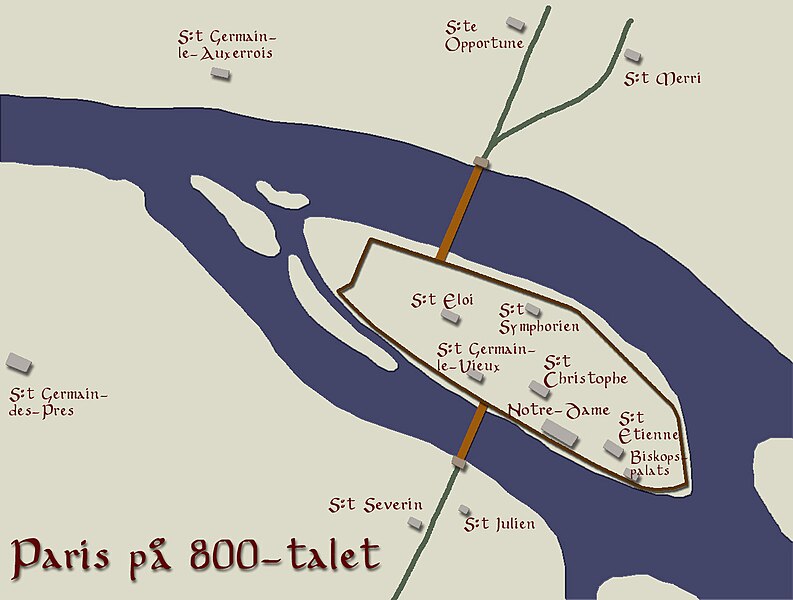Hello ladies and gents this is the Viking telling you that today we are talking about
VIKINGS IN PARIS
In March 845, a fleet of 120 Viking ships containing more than 5,000 men entered the Seine under the command of a chieftain named "Reginherus", or Ragnar. This Ragnar has often been tentatively identified with the legendary saga figure Ragnar Lodbrok, but the accuracy of this remains a disputed issue among historians. Around 841, Reginherus had been awarded land in Turholt, Flanders by Charles the Bald, but he eventually lost the land as well as the favour of the King.
Reginherus's Vikings raided Rouen on their way up the Seine in 845, and in response to the invasion, Charles—who was determined not to let the royal Abbey of Saint-Denis (near Paris) be destroyed—assembled an army which he divided into two parts, one for each side of the river. The Vikings attacked and defeated one of the divisions of the smaller Frankish army, took 111 of their men as prisoners and hanged them on an island on the Seine. This was done to honour the Norse god Odin, as well as to incite terror in the remaining Frankish forces.
The Vikings arrived in Paris on Easter Sunday, 29 March, entered the city and plundered it. During the siege, a plague broke out in their camp. The Norse had been exposed to the Christian religion, and after first praying to the Norse gods, they undertook a fast, acting on the advice of one of their Christian prisoners, and the plague subsided. The Franks could not assemble an effective defence and the Vikings withdrew only after being paid a ransom of 7,000 livres (French pounds) of silver and gold by Charles the Bald, amounting to approximately 2,570 kilograms (5,670 lb).
Considering the Vikings earlier loss of land to Charles, the substantial payment may also have been regarded as some form of compensation to the Viking leader and the invasion itself as an act of revenge This was the first of a total of thirteen payments of so-called Danegeld to Viking raiders by the Franks (the term is not expressly known to have been used at this point). While agreeing to withdraw from Paris, the Viking army pillaged several sites along the coast on the return voyage, including the Abbey of Saint Bertin.
Although Charles had been criticised severely for granting the large ransom payment to the Vikings, he had other more critical issues to deal with at the same time, including disputes with his brothers, regional revolts and disgruntled nobles, as well as pressure from abroad. Since he would have trouble trusting his own counts to assemble and lead troops to defeat the large Viking force militarily, paying them off instead would buy Charles time, and possibly peace from further Viking raids—at least in the near future.
The same year, a Viking fleet sacked Hamburg, which had been elevated to an archbishopric by Pope Gregory IV in 831 on the initiative of Louis the Pious to oversee the Saxon territory and to support the introduction of Christianity to Scandinavia. In response, the Frankish king Louis the German sent a diplomatic mission, headed by Count Cobbo (one of two court counts), to the court of Horik, demanding that the Danish king submit to Frankish overlordship and pay reparations for the invasion.
Horik eventually agreed to the terms and requested a peace treaty with Louis, while also promising to return the treasure and captives from the raid. Horik most likely wanted to secure the border with Saxony as he faced a conflict with King Olof of Sweden and domestic struggles. By the treaty, Louis demanded Horik's obedience, which was further secured by Horik regularly sending embassies and gifts to Louis and his suspension of support to Viking raiders.
Although many Vikings had died in the plague during the siege of Paris, Ragnar lived to return home to King Horik. According to a story originating from a member of Cobbo's embassy, Ragnar, having attacked the Abbey of Saint-Germain-des-Prés, then in the outskirts of medieval Paris and which Cobbo later visited, attributed the plague to the power of Saint Germain of Paris.
While Ragnar showed the gold and silver he had acquired to Horik and boasted about how easy he thought the conquest of Paris had been, he reportedly collapsed crying while relating that the only resistance he had met was from the long deceased saint.
As several of Ragnar's men died not long after, the king was so frightened that he ordered the execution of the survivors and the release of his Christian captives. This event, in part, led Horik to receive Archbishop Ansgar, "Apostle of the North", on friendly terms in his own kingdom.
Vikings returned again and again in the 860s and secured loot or ransom but, in a turning point for the history of France, the city's walls held against the Vikings' greatest attacking force in the siege of Paris (885–86) and as always have a chilled day from the Viking

Comments
Post a Comment